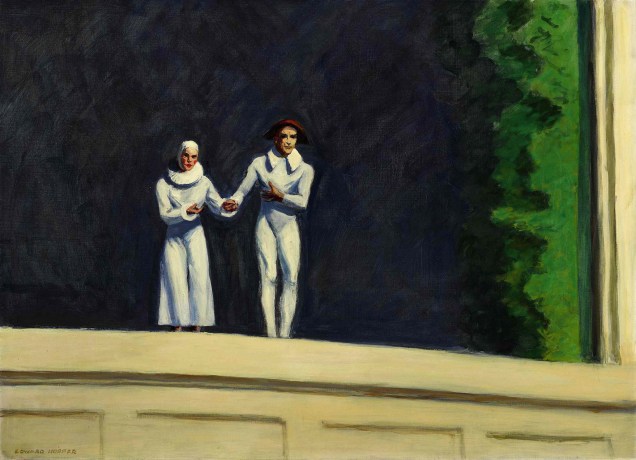

An early career-making painting, with the figure of a pretty woman, sold for much more than his last, more somber work.
‘Let me tell you about the very rich,” F. Scott Fitzgerald wrote in “The Rich Boy” in 1926. “They are different from you and me.” What better way to frame the sale last week of two paintings by Edward Hopper (1882–1967) at Christie’s and Sotheby’s. Fitzgerald’s was the voice of the Twenties, a Jazz Age philosopher and medium. Hopper was a product of the Twenties and another of its sages. Paintings from the late 1920s, such as Chop Suey, sold at Christie’s, made him famous as soon as they flew off his easel.
And you have to be very rich to spend $91.9 million on a painting. That was the price, including buyer’s commission, for Chop Suey, from 1929. The buyer of Two Comedians at Sotheby’s spent $12.5 million. It was painted in 1966 and was the last thing Hopper finished. He who has nearly $13 million to spend on a picture is very rich, too.
I’ll write about two stories. The first is a museum story. The second is about the differences between what matters to an art historian and what matters to the marketplace.
Barney Ebsworth, a Seattle travel entrepreneur, bought Chop Suey in 1973. He died in April. His estate sold the picture at Christie’s. In 2006, the Seattle Art Museum announced with fanfare that Ebsworth and other Seattle collectors had jointly agreed to give a massive haul of good art, valued at a billion dollars, to the newly expanded museum. Among the gifts were Chop Suey and many other things sold at Christie’s.
I was impressed, until I wasn’t. The Seattle Art Museum is a fine place of which I’m very fond. Its director at the time, Mimi Gates, was one of my mentors. The collectors in Seattle were great people with lots of money, good taste, and civic pride. Most of them made their own money. They’re down-to-earth. It made sense, with the newly expanded museum opening and Seattle itself booming, that these collectors would propel it to the top of the museum world.
I quickly learned that the gifts were almost all either promised or fractional gifts. This was new to me. I was the director of a starchy New England academic art museum, and before that a curator of another starchy New England academic art museum. I went to starchy New England schools. Promised and fractional gifts were tacky. It’s something people out West did, “out West” starting somewhere in Greenwich. If you were going to give something, just give it. It’s bad taste to bargain with a charity. It tends to mean messy entanglements over the art’s possession, fussing about someone else’s taxes, what the world of romance would call “long engagements,” and an obvious unanswerable. A promise to do something can just as well mean a promise to break the promise. “Out West,” though, such promises were common tools of philanthropy.
So I soon knew that the press release announcing this massive gift was worth more than the paper it was printed on — sometimes the gifts do happen — but much less than a billion dollars.
“There’s many a slip twixt the cup and the lip.” I think lots of writers take credit for this. Robin once said it to Batman, but Homer, Cicero, Cervantes, and Trollope used it, too. Stewarding a promised gift is, in a way, more arduous than a gift merely lusted after. The promise maker might see himself as having an exalted status and persuade himself that he has given something of value for which he merits endless thanks and special treatment. There’s new uncertainty in the relationship. A director will think, Can I finally ask him for money? Or, as the promise maker might prefer, Should I let him off the hook for now? Directors like to close gifts and move to the next donor. With a promised gift, nothing is closed. Things are awkwardly ajar.
The art press is right to demand answers from the Seattle Art Museum. Yes, it’s a private museum, but it takes public funds. The Ebsworth collection, which sold for more than $300 million, was said by the museum to be destined for the public trust, owned and shown by the museum for the public’s benefit. The Seattle Art Museum is silent, which means it wants to change the subject, which possibly means it bungled the gift. Of course, we don’t know the complete story. Who bought Chop Suey? What did Ebsworth do for the museum in his will? The current director has suddenly retired. This raises suspicions.
I don’t think the museum egregiously mishandled anything. Ebsworth was a Seattle newcomer. He made his money in St. Louis, where he lived for years. His links to the city were tenuous. He was a big presence but also an arriviste in a tight, small cultural elite. In addition to great art, he’d acquired four wives, so there was a complicated private life. Ebsworth had a will-o’-the-wisp, come-what-may attitude. The Seattle museum, like Seattle itself, is a bit of a boom-and-bust place. Its new building involved a novel deal between the museum and Washington Mutual, so when the bank collapsed, the museum felt the tsunami more than most. Ebsworth might have had enough mess already. Donors move on, too.
Two directors followed Mimi Gates, one of the best fundraisers and networkers I’ve known. Both are good people, but I don’t see either as Ebsworth’s type. Of the museum’s curators, if I were a rich donor, I’d rather put a bullet in my head than spend time with at least one of them. I think Ebsworth never took the promise too seriously. The museum had too many problems. He simply lost interest, got sick, left every knotty problem to his heirs, and died a happy man. And many a happy man and woman work at Christie’s today. The sale made the place tens of millions.
Why did one early Hopper sell for $91.9 million and one end-of-career Hopper go for $12.5 million? Reading the art market based on two sales is like reading election results for one contest. There’s reasonable speculation and fair and unfair extrapolation in both. Each of the two Hoppers has a supply issue. In the late 1920s, Hopper becomes the Hopper we know, and pictures such as Chop Suey made his reputation. His city scenes are bright, shiny, and creepy. The new and sleek jostle with the shabby. People seem alone even when they’re together, and when they’re alone, they seem hermetically sealed from the world. Of these late-Twenties pictures, aside from Chop Suey, only one is privately owned. Starting in the late 1920s, as soon as Hopper finished a picture, a museum tried to buy it. So Ebsworth’s picture was a lone example of the artist at his zenith.
There’s a supply issue with Two Comedians, too. There’s only one last painting, and this is it. It’s very consciously Hopper’s swan song, a farewell gesture from him and the other figure, his wife, Jo. Art historians like me love end-of-life pictures because they’re often summations. They show an artist’s big, core issues, unsullied by concerns about the art critics or patrons or dealers, which matter less. Art done in the shadow of death is often tough to bear, and that affects the price. Two Comedians shows old people, and old people are downers.

Chop Suey shows a pretty young woman, and never underestimate how much youth and beauty can drive price. It’s got narrative, which the viewer can supply from his or her own imagination, and it has a setting. Two Comedians is straightforward. Hopper is at his best in what I call “indoor/outdoor” pictures: interior scenes with windows showing an outdoor world. Two Comedians, like many late Hoppers, is stripped down. It’s austere and bare. Hopper also is not a 1960s artist. Andy Warhol is. Though Hopper painted superb, fascinating things in the ’60s, and this is one of them, they’re outliers for collectors of American modernism, which is, roughly, works from 1900 to the early 1950s. There are separate markets for Hopper’s architecture paintings, which are great, but big spenders want figures. He’s a city painter, so his Cape Cod and Gloucester paintings sell for far less, though I think they’re as good. There’s an entirely separate market for his watercolors, some of which are flat as old seltzer. His art from the Teens and early Twenties is mixed in quality and evolutionary in style.
Chop Suey is new to the market, too. Ebsworth owned it for nearly 50 years. Two Comedians was in the marketplace as recently as 1995. In my opinion, that Frank Sinatra once owned it gave it great cachet. I think it does show not only how famous Hopper was but also how his image-making crept into so much of the American psyche. I remember when Hopper died in 1967. Even as a child, I knew who he was. His obituary was a front-page story in every newspaper.
Christie’s and Sotheby’s did a good, scholarly job on their catalogue entries for both pictures. Sotheby’s put Jo Hopper in the center of its treatment of Two Comedians. It was keenly aware of buyer psychology. Better get the wife on board if rich hubby’s planning to spend millions on a picture. Both auction houses covered the many inspirations from which Hopper drew. For Two Comedians, the words “Hitchcock,” “voyeur,” “the unknown,” “artifice,” “darkness,” and “disconnect” appear. The entry ends with the lyrics from Stephen Sondheim’s “Send in the Clowns,” from A Little Night Music, a favorite of mine but an acquired taste. Clive Barnes called this Sondheim “heady, civilized, sophisticated, and enchanting.” It’s a fair appraisal of both the musical and Hopper’s painting. It might explain why the musical wasn’t a huge success and the picture was in the very low seven figures.
The essay for Chop Suey, also sensitive and smart, focuses on the French impressionists, who were most famously painters of everyday city life. They certainly inspired Hopper, who lived in Paris while Monet and Renoir were working. Impressionism wasn’t an avant-garde movement then, but it was much in favor among young Americans. Hopper’s picture is recognizably from the age of the flapper. It gives some context to what were then the ubiquitous chop-suey joints in lower Manhattan. The food term means “this and that,” a good description of city life. Its young women are on display in the sense that we are eavesdroppers. It’s flashy and neon and has a sense of developing drama rather than the concluded drama of Two Comedians. In this rarefied part of the art market, these little differences are worth millions.
